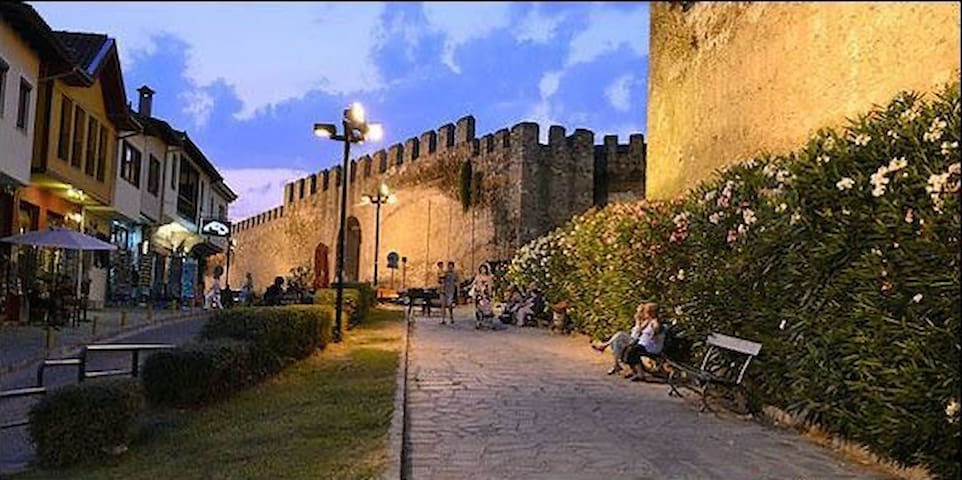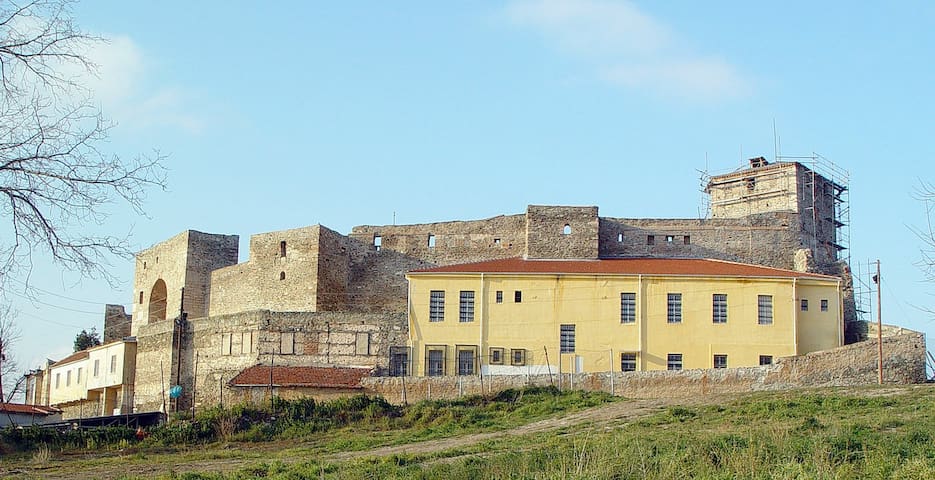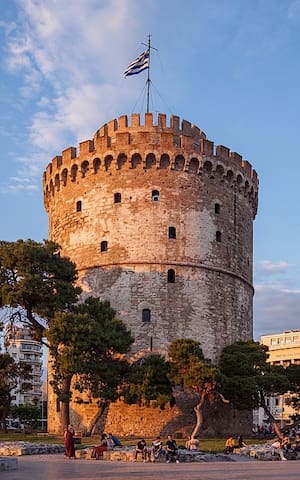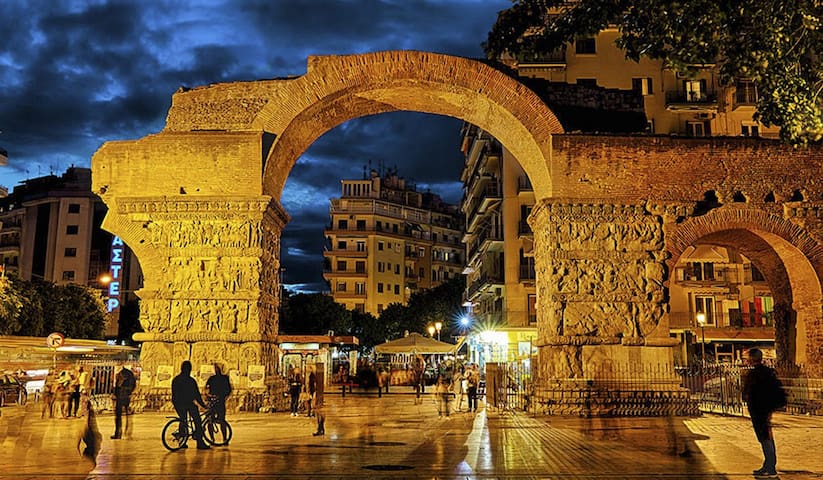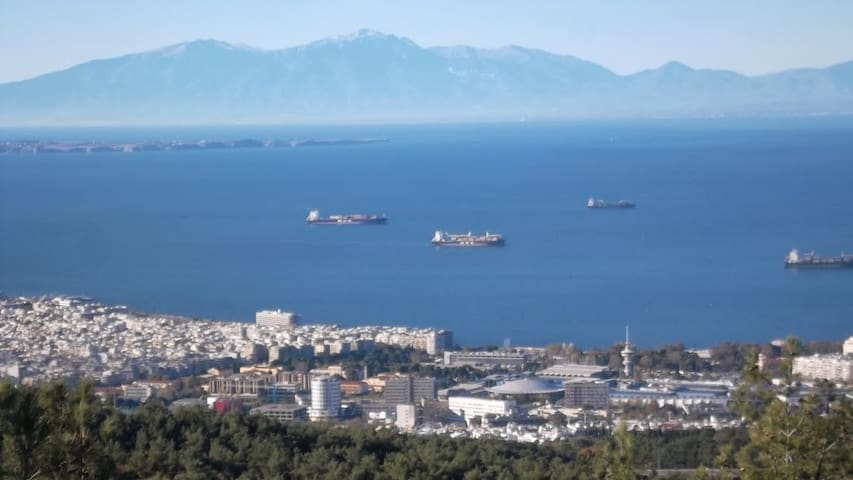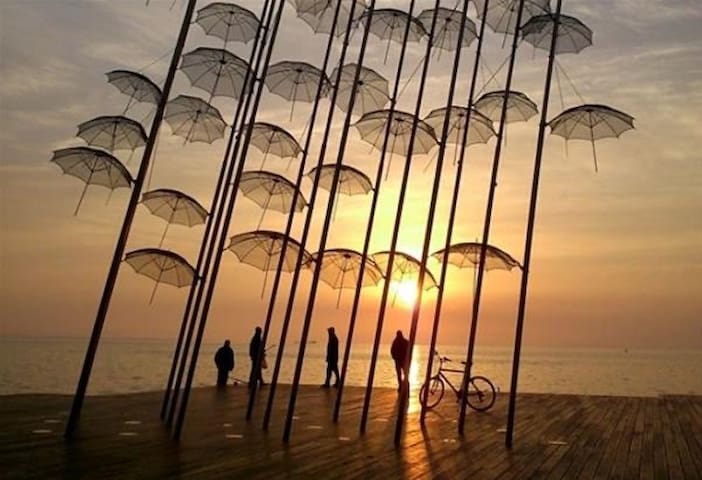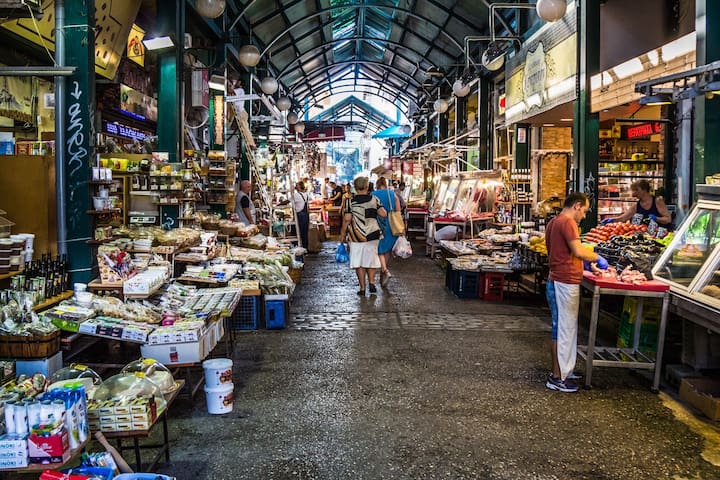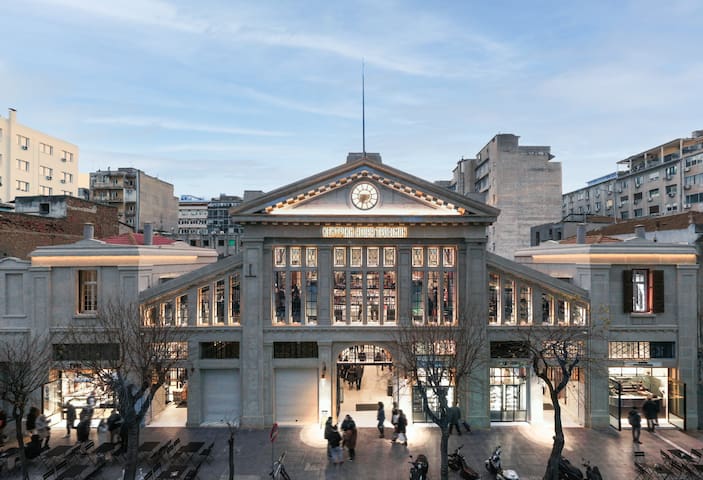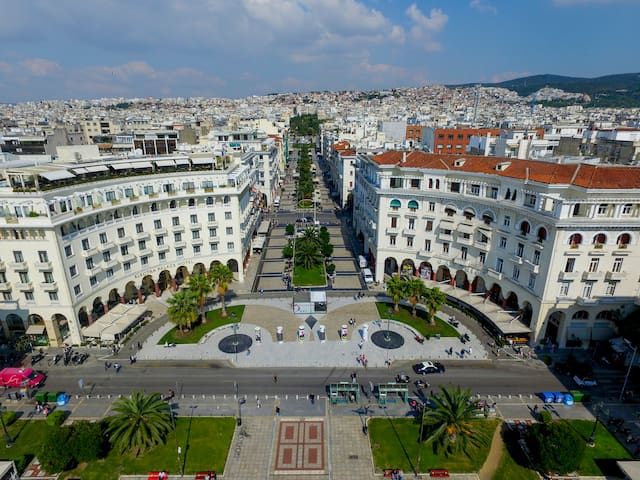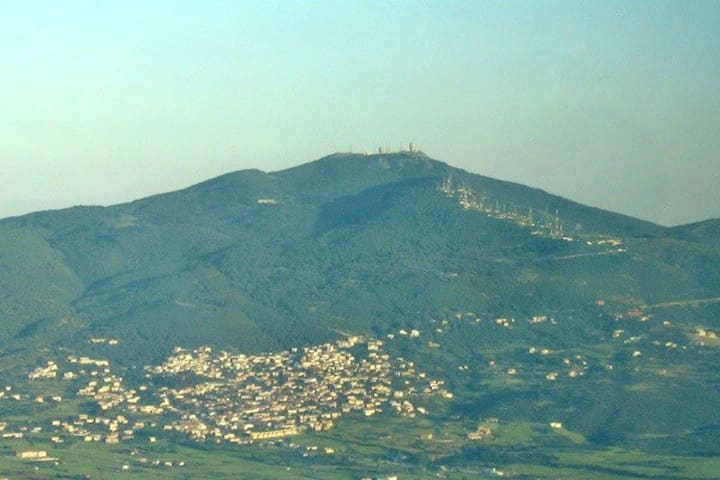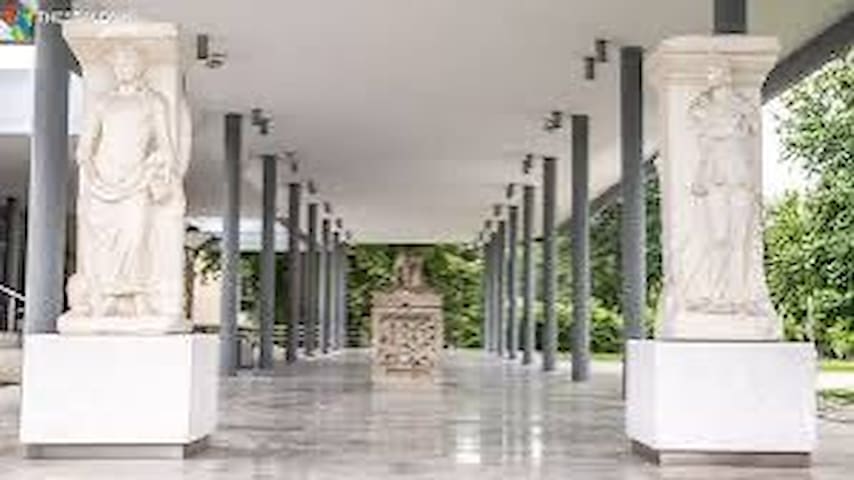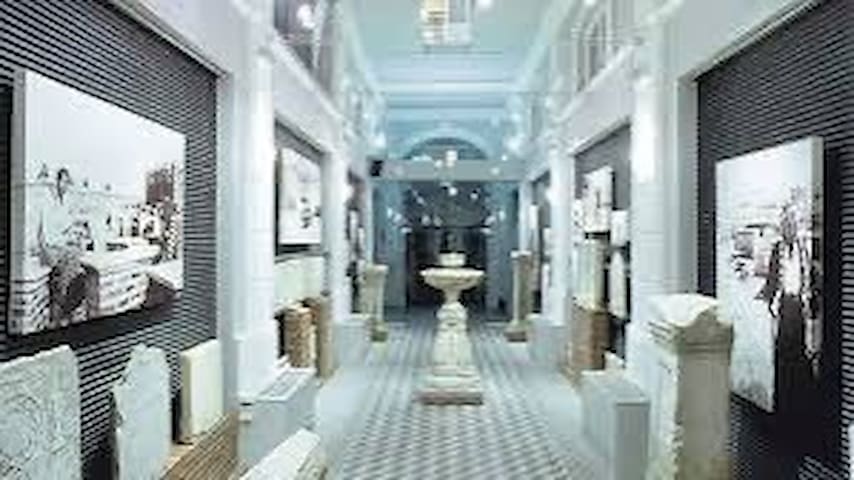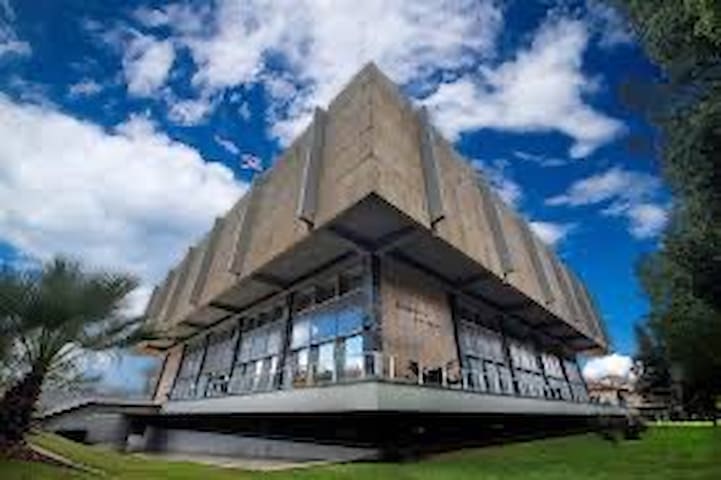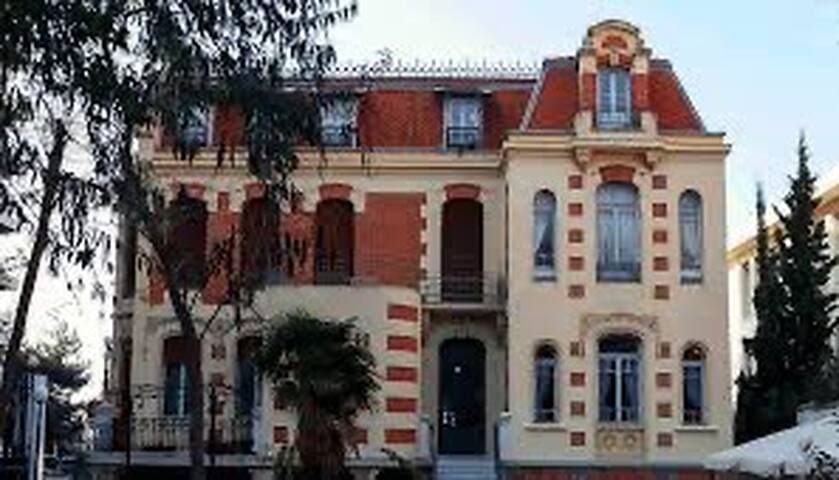Food- Drink
This establishment is located right below the apartment and has been awarded in 2019 and 2020 and 2023 as one of the best bars in Greece!
21 ντόπιοι το προτείνουν
Le Coq tail mix bar
2 Leof. OchiThis establishment is located right below the apartment and has been awarded in 2019 and 2020 and 2023 as one of the best bars in Greece!
Sightseeing
Just five minutes walk from the apartment the Tower of Trigonio offers a panoramic view of Thessaloniki and is recommended for visiting and photos
66 ντόπιοι το προτείνουν
Kastra
Just five minutes walk from the apartment the Tower of Trigonio offers a panoramic view of Thessaloniki and is recommended for visiting and photos
Historical Museum of Thessaloniki
In the 1890s, the fortress was converted into a prison. The exact date is not known with certainty, but the prison is mentioned on an 1899 map of the city, providing a terminus ante quem for the change. This conversion entailed the removal of all the previous buildings inside the castle, of which no trace survives today. The changes to the fortifications were not significant, although their primary role was reversed: from protecting residents from external threat, they now served to isolate prisoners from the outside world. The jail long served as the city's main correctional facility, where prisoners of any gender or crime were held. New buildings were built along both sides of the walls to improve the functionality of the new penitentiary. The inner courtyard was divided by fences into five separate units, and the central courtyard housed the main observation post in the centre.
The prison had a chapel and other annexes, while the annex located north-east tower was destroyed during the Second World War. The outer buildings, on the south side of the castle, housed the administration, the women's prison, and to the west, the solitary confinement cells. This centre had gained a bad reputation during the Metaxas regime, the Occupation, and in the post-war period from the Greek Civil War to the Junta (the regime of the Colonels).
70 ντόπιοι το προτείνουν
Ιστορικό Μουσείο Σαλονίκης
130 EptapirgiouHistorical Museum of Thessaloniki
In the 1890s, the fortress was converted into a prison. The exact date is not known with certainty, but the prison is mentioned on an 1899 map of the city, providing a terminus ante quem for the change. This conversion entailed the removal of all the previous buildings inside the castle, of which no trace survives today. The changes to the fortifications were not significant, although their primary role was reversed: from protecting residents from external threat, they now served to isolate prisoners from the outside world. The jail long served as the city's main correctional facility, where prisoners of any gender or crime were held. New buildings were built along both sides of the walls to improve the functionality of the new penitentiary. The inner courtyard was divided by fences into five separate units, and the central courtyard housed the main observation post in the centre.
The prison had a chapel and other annexes, while the annex located north-east tower was destroyed during the Second World War. The outer buildings, on the south side of the castle, housed the administration, the women's prison, and to the west, the solitary confinement cells. This centre had gained a bad reputation during the Metaxas regime, the Occupation, and in the post-war period from the Greek Civil War to the Junta (the regime of the Colonels).
The White Tower of Thessaloniki is a 15th century Ottoman fortification project (probably built between 1450-70). Today it is considered a characteristic monument of Thessaloniki and is all that has been saved from the demolished Ottoman fortifications of the city. The current form of the tower replaced a Byzantine fortification of the 12th century to be used later as a Janissary guard and as a death row prison. Today it functions as a museum and is one of the most famous buildings-symbols of cities in Greece. It has 6 floors, 34 meters high and 70 meters perimeter. The White Tower overlooks the beach of Thessaloniki.
540 ντόπιοι το προτείνουν
Λευκός Πύργος Θεσσαλονίκης
The White Tower of Thessaloniki is a 15th century Ottoman fortification project (probably built between 1450-70). Today it is considered a characteristic monument of Thessaloniki and is all that has been saved from the demolished Ottoman fortifications of the city. The current form of the tower replaced a Byzantine fortification of the 12th century to be used later as a Janissary guard and as a death row prison. Today it functions as a museum and is one of the most famous buildings-symbols of cities in Greece. It has 6 floors, 34 meters high and 70 meters perimeter. The White Tower overlooks the beach of Thessaloniki.
Αψίδα του Γαλερίου
144 EgnatiaCara Tepe Hill
With a breathtaking view, this hill is known by many people who stay in Thessaloniki, it is located on the way to the Hotel Philippio. View the city from the highest nearby point and take pictures
Cara Tepe Hill
Cara Tepe Hill
With a breathtaking view, this hill is known by many people who stay in Thessaloniki, it is located on the way to the Hotel Philippio. View the city from the highest nearby point and take pictures
Take a stroll along the beach of Thessaloniki from the White Tower to the Music Hall and see the sunset, various talented street musicians, city groups so you will see that there is something magical about the city and you will understand why everyone loves it as much as they visit it.
70 ντόπιοι το προτείνουν
Ομπρέλες Ζογγόπουλος
Take a stroll along the beach of Thessaloniki from the White Tower to the Music Hall and see the sunset, various talented street musicians, city groups so you will see that there is something magical about the city and you will understand why everyone loves it as much as they visit it.
Kapani Market
It is located in the city centre and consists of pedestrian streets (Menexe, Vlali, Solomou, Askimou, Chalkeon, Kydoniati, Spandoni, and other smaller streets) enclosed by Egnatia, Aristotelous, Ermou and Venizelou streets. The other traditional markets of the centre, Modiano, Athonos Square and Bezestini, are also very close by. The buildings of the market are two-storey, while some of the sidewalks are covered. The name "Kapani" comes from the Turkish phrase Un-Kapan, meaning flour market. The market sells food, spices, household items, clothing, etc.
68 ντόπιοι το προτείνουν
Αγορά Καπανή
VlaliKapani Market
It is located in the city centre and consists of pedestrian streets (Menexe, Vlali, Solomou, Askimou, Chalkeon, Kydoniati, Spandoni, and other smaller streets) enclosed by Egnatia, Aristotelous, Ermou and Venizelou streets. The other traditional markets of the centre, Modiano, Athonos Square and Bezestini, are also very close by. The buildings of the market are two-storey, while some of the sidewalks are covered. The name "Kapani" comes from the Turkish phrase Un-Kapan, meaning flour market. The market sells food, spices, household items, clothing, etc.
Market in Modiano
Modiano Market is a closed (covered) market in the centre of Thessaloniki. It is part of the block surrounded by Aristotelous, Ermou, Komninon and Vasileos Heraklion streets. It was built by the engineer Eli Modiano in 1922. It houses mainly food shops (butchers, fishmongers, etc.), but also some taverns, restaurants and bars.
61 ντόπιοι το προτείνουν
Αγορά Μοντιάνο
33 KidoniatouMarket in Modiano
Modiano Market is a closed (covered) market in the centre of Thessaloniki. It is part of the block surrounded by Aristotelous, Ermou, Komninon and Vasileos Heraklion streets. It was built by the engineer Eli Modiano in 1922. It houses mainly food shops (butchers, fishmongers, etc.), but also some taverns, restaurants and bars.
Aristotelous Square
Aristotelous Square is one of the central squares of Thessaloniki. It starts from the semi-circular buildings to the north of Mitropoleos Street, which crosses it at this point, and continues to Nikis Avenue, at the sea. The square is a popular spot for tourists and locals alike, with many refreshment bars and cafes, and is a venue for political gatherings and a variety of artistic events. The above imposing buildings on Mitropoleos Street house a hotel and the Olympion Cinema.
216 ντόπιοι το προτείνουν
Aristotelous Square
Aristotelous Square
Aristotelous Square is one of the central squares of Thessaloniki. It starts from the semi-circular buildings to the north of Mitropoleos Street, which crosses it at this point, and continues to Nikis Avenue, at the sea. The square is a popular spot for tourists and locals alike, with many refreshment bars and cafes, and is a venue for political gatherings and a variety of artistic events. The above imposing buildings on Mitropoleos Street house a hotel and the Olympion Cinema.
Γειτονιές
Ladadika
Ladadika is a historic district of the city of Thessaloniki. It is divided into the districts of Ladadika and Ano Ladadika. The Ladadika area is bounded by the streets "Ionos Dragoumi", "Tsimiski", "Salaminos" and "Admiral Kountouriotou" while Ano Ladadika is bounded by the streets "Tsimiski", "Fragon", "Leo Sofou", "Dodekanissou", "Vasileos Herakliou" and "Verias". The boundaries of the area are defined by the decree declaring it a "historic site" (Hellenic Ministry of Environment and Tourism/DILAP/G/24917/1598/24.5.85) and its area is 6.5 hectares and includes 24 economic islands, where around 300 business units are located, employing around 1400 workers.
The area is located near the Port of Thessaloniki and for centuries it was one of the most important commercial centres of the city. The name Ladadika itself comes from the existence of many wholesale shops in the area where mainly olive oil was sold. Many Jews of Thessaloniki lived in the area, making it the old Jewish quarter of Thessaloniki, while the area inhabited by French and Italian merchants, "Frangomachalas", is located right next to the Ano Ladadika area.
In the years before the First World War many brothels and taverns began to appear in the area, and after the Great Fire of Thessaloniki the area lost its dynamism. The period of decline lasted until the great earthquake of 1978 when it was abandoned for about two decades. In 1985, Ladadika was declared an area of cultural value by the Ministry of Culture of Greece. The particular architectural style of the 19th century buildings is preserved and protected. The particular importance of the area lies in the fact that despite its small size, it gives the visitor an idea of how Thessaloniki was built before the 1917 fire that razed 70% of the city.
Today, having undergone a restoration process in the 1980s, Ladadika is an entertainment area of Thessaloniki, where many bars, nightclubs, restaurants and taverns are housed, where once there were oil shops and commercial warehouses. In Ladadika are the squares of Morihovo, Petrakaki Square, and in Upper Ladadika the Emporio Square with an exit to Polytechniou Street.
280 ντόπιοι το προτείνουν
Ladadika
Ladadika
Ladadika is a historic district of the city of Thessaloniki. It is divided into the districts of Ladadika and Ano Ladadika. The Ladadika area is bounded by the streets "Ionos Dragoumi", "Tsimiski", "Salaminos" and "Admiral Kountouriotou" while Ano Ladadika is bounded by the streets "Tsimiski", "Fragon", "Leo Sofou", "Dodekanissou", "Vasileos Herakliou" and "Verias". The boundaries of the area are defined by the decree declaring it a "historic site" (Hellenic Ministry of Environment and Tourism/DILAP/G/24917/1598/24.5.85) and its area is 6.5 hectares and includes 24 economic islands, where around 300 business units are located, employing around 1400 workers.
The area is located near the Port of Thessaloniki and for centuries it was one of the most important commercial centres of the city. The name Ladadika itself comes from the existence of many wholesale shops in the area where mainly olive oil was sold. Many Jews of Thessaloniki lived in the area, making it the old Jewish quarter of Thessaloniki, while the area inhabited by French and Italian merchants, "Frangomachalas", is located right next to the Ano Ladadika area.
In the years before the First World War many brothels and taverns began to appear in the area, and after the Great Fire of Thessaloniki the area lost its dynamism. The period of decline lasted until the great earthquake of 1978 when it was abandoned for about two decades. In 1985, Ladadika was declared an area of cultural value by the Ministry of Culture of Greece. The particular architectural style of the 19th century buildings is preserved and protected. The particular importance of the area lies in the fact that despite its small size, it gives the visitor an idea of how Thessaloniki was built before the 1917 fire that razed 70% of the city.
Today, having undergone a restoration process in the 1980s, Ladadika is an entertainment area of Thessaloniki, where many bars, nightclubs, restaurants and taverns are housed, where once there were oil shops and commercial warehouses. In Ladadika are the squares of Morihovo, Petrakaki Square, and in Upper Ladadika the Emporio Square with an exit to Polytechniou Street.
A village just outside the town at the foot of the homonymous mountain, offering coolness in summer and various restaurants with excellent food, a drive to the top will delight you as access is easy there! Chortiatis is located southeast of Thessaloniki, 18 km from the city center. During the Macedonian struggle, the Chortiatis fought with the most important Macedonian gladiator being the chieftain Georgios Alexopoulos. Chortiatis is where the Holocaust of Chortiatis took place during the Occupation, on September 2, 1944, by the German occupiers.
7 ντόπιοι το προτείνουν
Chortiatis
A village just outside the town at the foot of the homonymous mountain, offering coolness in summer and various restaurants with excellent food, a drive to the top will delight you as access is easy there! Chortiatis is located southeast of Thessaloniki, 18 km from the city center. During the Macedonian struggle, the Chortiatis fought with the most important Macedonian gladiator being the chieftain Georgios Alexopoulos. Chortiatis is where the Holocaust of Chortiatis took place during the Occupation, on September 2, 1944, by the German occupiers.
Very close to the city of Thessaloniki and just after the airport, the settlement of Peraia is a seaside village and is a magnet for the people of Thessaloniki who go there for a nice seafood meal right next to the sea. From spring onwards you can go by boat through the sea and see Thermaikos and Thessaloniki from a different perspective.
53 ντόπιοι το προτείνουν
Peraia
Very close to the city of Thessaloniki and just after the airport, the settlement of Peraia is a seaside village and is a magnet for the people of Thessaloniki who go there for a nice seafood meal right next to the sea. From spring onwards you can go by boat through the sea and see Thermaikos and Thessaloniki from a different perspective.
Museums
Archaeological Museum of Thessaloniki
The Archaeological Museum of Thessaloniki is one of the largest museums in the country and the central museum of Northern Greece. With unique collections of ancient artefacts, with rich activity and extroversion, it is always ready to welcome its visitors.
275 ντόπιοι το προτείνουν
Αρχαιολογικό Μουσείο Θεσσαλονίκης
6 Manoli AndronikouArchaeological Museum of Thessaloniki
The Archaeological Museum of Thessaloniki is one of the largest museums in the country and the central museum of Northern Greece. With unique collections of ancient artefacts, with rich activity and extroversion, it is always ready to welcome its visitors.
Μουσείο Βυζαντινού Πολιτισμού
2 Leof. StratouMuseum of Byzantine Culture
Jewish Museum of Thessaloniki
11 Ag. MinaΠολεμικό Μουσείο Θεσσαλονίκης
4 Grigoriou Lampraki War Museum of Thessaloniki
Folklore & Ethnological Museum of Macedonia & Thrace
22 ντόπιοι το προτείνουν
Λαογραφικό & Εθνολογικό Μουσείο Μακεδονίας & Θράκης
1 Filippou NikoglouFolklore & Ethnological Museum of Macedonia & Thrace
Thessaloniki Olympic Museum
Leoforos 3is SeptemvriouPark in the countryside
The Axios Delta National Park (Axios - Loudia - Aliakmonas National Park) includes the Kalochori Lagoon of Thessaloniki, the estuary of the French River, the delta of the Axios River and its bed up to the Greek border, the delta of the Aliakmonas River, the wetland of Nea Agathoupolis and the wetlands of Aliki Ktronos. The protection afforded to the area to date is due to its inclusion in 1971 in the Ramsar Convention as a Wetland of International Importance and its inclusion in the Natura 2000 network of sites. It has also been included in the list of Important Bird Areas
Εθνικό Πάρκο Δέλτα Αξιού


